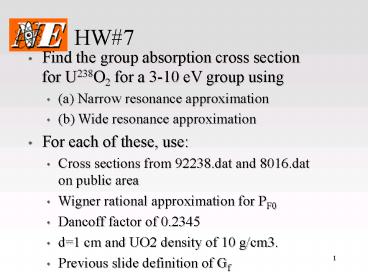HW - PowerPoint PPT Presentation
1 / 22
Title: HW
1
HW7
- Find the group absorption cross section for
U238O2 for a 3-10 eV group using - (a) Narrow resonance approximation
- (b) Wide resonance approximation
- For each of these, use
- Cross sections from 92238.dat and 8016.dat on
public area - Wigner rational approximation for PF0
- Dancoff factor of 0.2345
- d1 cm and UO2 density of 10 g/cm3.
- Previous slide definition of Gf
2
Lesson 8 Objectives
- Effects of irradiation and decay
- Reading decay chain charts
- Translating decay chain charts into differential
equations - Xenon and Samarium
- Burnable poisons
3
Effects of irradiation and decay
- The reactor composition changes with time due to
irradiation effects and radioactive decay - These effects must be taken into account in the
design of the reactorin fact may be the primary
design consideration of the reactor itself (e.g.,
SRP production reactors, HFIR reactor) - In this lesson we will write down the equations,
discuss their solution, and examine the important
decay chains - In addition, we will look at the important design
considerations brought on by burnup
4
Equations and solutions
- Reactor isotopic changes occur for two reasons
irradiation effects (primarily due to fission and
transmutation) and radioactive decay - Figure 6.1 shows the transmutation-decay chains
for U-238 and Th-232 (alpha decay ignored) - Notice the overlap (i.e., the two charts fit
together) - Fertility from Th-232 and U-238
5
Eqns and solutions (2)
6
Eqns and solutions (3)
7
Eqns and solutions (4)
- In general, an equation can be written for each
isotope in the reactor, with some combination of
these terms - Eqn. 6.3
- Note that this is given in the text for fission
products, but is generally applicable to all
isotopes - Note also the flux terms as combining with
decay constants (helpful to convert flux to
/bn/sec and decay constants to 1/sec)
8
Eqns and solutions (5)
- The equations on pp. 199-201 of the text
translate these relations into the
transmutation-decay chains of interest to us,
with some shortcuts - Long-lived decay is ignored (e.g., alpha)
- Some short-lived decay is considered
instantaneous - The non-iterative linking of these equations
allows for simple ODE chain solutions (See
Example 6.1 on p. 203)
9
Solution of equations
10
Solution of equations
- For no source
- For constant source
- For exponential source
11
Eqns and solutions (6)
- More formally, the linked equations can be
translated into a simple matrix ODE - with solution
- Note that the burnup time steps are imposed
because A and F depend on flux. The flux at ti
is used for times up to ti1, when it is updated
again - The solution depends on this freezing of flux
dependence and its accuracy will depend on the
size of the time steps
12
Consequences of burnup
- Drop in k-effective as fuel burns out and fission
products are built up - Somewhat compensated for by Pu-239 build-in
- Unit of MWD/tonne of HM (consumption of 1 g
U-235 1.07 MWD, therefore 100 enriched would
burn to give 1 million MWD/tonne) - Generally run BWRs and PWRs with fuel loadings
that include different batches of fuel with
differing burnups (at each shutdown replacing
most burned-up with fresh fuel and reshuffling)
13
14
15
Consequences of burnup (2)
- Samarium and Xenon build-in and decay
- Both are poisons (Xe about 50x more absorptive
per atom) and both reach an equilibrium at
constant reactor flux level - Reactivity held in Xenoneffect on k-effective
of the steady-state Xe absorption - After shutdown from steady state
- Sm goes to a higher equilibrium
- Xe rises to a peak and then decays away
- Reactivity effect important (especially Xenon) to
restart times for reactors - Reactivity effect also important for power level
changes
16
17
18
19
20
21
Consequences of burnup (3)
- Burnable poisons Put in to flatten reactivity
profile and extend reactor life
22
HW8
- In a Pu239 thermal system with f1014 n/cm2/s,
what is the rate of production of Pu240 and Pu241
in grams/cm3/day? (Assume Pu239 density is 0.01
g/cm3.) - Derive Equations 6.10, 6.11, 6.12, 6.16, 6.17,
and 6.19 (plus the f threshhold in the note
before 6.19). - Estimate the U235 density (g/cm3) and flux
(/cm2/sec) implied in Figures 6.5 and 6.6.































